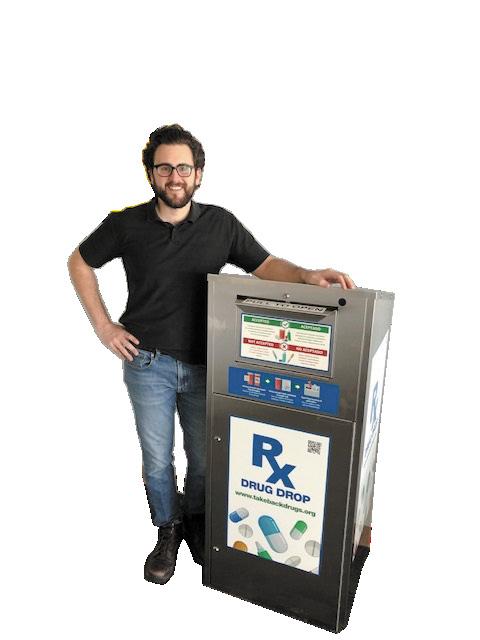Getting unwanted drugs to where they can do no harm Instead of harming people or the environment, medications are incinerated b y A llen P ie r leoni
C
Flavio Alfaro, Supervisor of Property & Evidence Unit, for the San Diego Sheriff’s Department, shown in evidence room where drug boxes are received, processed, labeled, stored, and later disposed of according to law. Photo courtesy of San Diego County Sheriff’s Department
alifornia leads the nation in addressing issues that are vital to the public health and safety, and the environment. One crucial piece is the California Statewide Drug Take-Back Program, funded by the California Department of Health Care Services and administered by the California Product Stewardship Council (CPSC). The program targets the opioid crisis and the mishandling of other controlled and over-the-counter medicines. At its heart is a statewide network of Medication Take-Back Bins, placed in law-enforcement agencies, pharmacies and hospitals with pharmacies for public use. Anyone can anonymously deposit unused and expired medications into the bins, rather than endanger the environment and possibly lives by flushing them down the toilet, throwing them in the trash or stockpiling them at home. The discarded medicines are
incinerated at waste-to-energy plants. In one way or another, thousands of people across California touch this process in some way, including Colleen Foster, Environmental Officer with Oceanside’s Water Utilities Department.
“The program is ... one that we’ll all benefit from and in many ways.” Colleen Foster Environmental Officer, Oceanside Water Utilities Department
Foster’s involvement with the take-back program goes back years, she says. “I’ve served on the Board of Directors for CPSC for years and am glad to see that their years of hard work
installing these bins across the state are bearing fruit, most recently with the California Drug Take-Back Program, which resulted in a number of safe disposal med bins being installed in San Diego County and surrounding areas.” At the San Diego County Sheriff’s Department, Flavio Alfaro, Supervisor of the Property & Evidence Unit, works to maintain 26 collection bins inside the lobbies of the department’s stations, substations and jails throughout the county. Since the adoption of the program, it has collected “more than 128,000 pounds of miscellaneous medication for destruction,” Alfaro says. Feedback from the public has been “great,” Flavio says. “People are always grateful to see so many new bins close in their county. Without the bins, unwanted medicine would likely fall into the wrong hands or end up polluting our environment,” Alfaro says. Foster and Alfaro share the belief
that unwanted medicines currently aren’t disposed of correctly when residents throw them in their trash or flush them down the toilet. In some cases, when the elderly store and consume unwanted medicines because they were mistaken for medicines that should be consumed, they cause irreparable harm. Both Foster and Alfaro believe that the elderly appreciate the new med bin options in their community and are among the most popular users of the med bins. The bins are also frequented by cautious parents concerned about their children getting access to medications. “The program is a valuable resource for the citizens of San Diego County, one that we’ll all benefit from and in many ways,” says Foster. To find a med bin near you, visit www.takebackdrugs.org.
Fight the opioid crisis
128 Americans die every day
from an opioid overdose, says the National Institute on Drug Abuse.
45%
of drug overdoses are estimated to be opioid-related. In California, that’s more than 2,400 deaths each year.
Millions of Americans
are addicted to opioids, such as hydrocodone, morphine, and oxycodone. Abuse of these powerful painkillers takes a toll that goes far beyond individuals and their families.
$78.5 billion
represents the annual economic burden of opioid abuse, according to the Centers for Disease Control and Prevention. This includes health care, treatment, law enforcement, and lost productivity.
6 | NEW SAFE DISPOSAL OPTIONS! | CPSC | A Special Advertising Supplement
Many people who misuse opioids get them from a friend or relative — often without that person’s knowledge. By removing the risk of unused opioids in your home, you can help address the devastating opioid crisis affecting so many American families. Proper disposal of unused prescription opioids saves lives.




